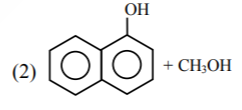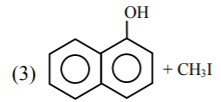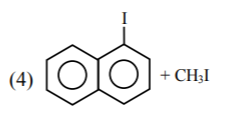What product are obtained when 1-Methoxy napthalene reacts with hydroiodic acid?




To determine the products obtained when 1-Methoxy naphthalene reacts with hydroiodic acid (HI), we can follow these steps:
Step 1: Understand the Structure of 1-Methoxy Naphthalene
1-Methoxy naphthalene is a naphthalene ring with a methoxy group (-OCH3) attached to the first carbon. The structure can be represented as follows:
OCH3|/∣| ∣
Step 2: Reaction with Hydroiodic Acid
When 1-Methoxy naphthalene reacts with hydroiodic acid (HI), the methoxy group (-OCH3) can undergo protonation by the hydrogen ion (H+) from HI. This makes the oxygen atom positively charged, leading to the formation of a more reactive species.
Step 3: Formation of the Intermediate
The protonation of the methoxy group results in the formation of a methoxy cation:
O+|/∣| ∣
Step 4: Nucleophilic Attack by Iodide Ion
The iodide ion (I-) from HI can now act as a nucleophile. It can attack the positively charged carbon atom that was originally attached to the methoxy group. This leads to the cleavage of the C-O bond.
Step 5: Final Product Formation
After the nucleophilic attack, the final products will be:
1. 1-Iodo naphthalene (where the methoxy group is replaced by an iodine atom).
2. Methanol (CH3OH) as a byproduct.
The final structure can be represented as:
I|/∣| ∣
Summary of Products
The products obtained from the reaction of 1-Methoxy naphthalene with hydroiodic acid are:
- 1-Iodo naphthalene
- Methanol
1-Methoxy naphthalene is a naphthalene ring with a methoxy group (-OCH3) attached to the first carbon. The structure can be represented as follows:
When 1-Methoxy naphthalene reacts with hydroiodic acid (HI), the methoxy group (-OCH3) can undergo protonation by the hydrogen ion (H+) from HI. This makes the oxygen atom positively charged, leading to the formation of a more reactive species.
The protonation of the methoxy group results in the formation of a methoxy cation:
The iodide ion (I-) from HI can now act as a nucleophile. It can attack the positively charged carbon atom that was originally attached to the methoxy group. This leads to the cleavage of the C-O bond.
After the nucleophilic attack, the final products will be:
2. Methanol (CH3OH) as a byproduct.
The products obtained from the reaction of 1-Methoxy naphthalene with hydroiodic acid are:
- 1-Iodo naphthalene
- Methanol
Similar Questions
Knowledge Check
What is obtained when ethyl methyl ether is treated with hydroiodic acid ?
ACH3−O−C2H4IBCH3−O−C2H5CC2H5I+CH3OHDCH3I+C2H5OHWhat is the product formed when acetylene reacts with hypochlorous acid.
ACH3COClBClCH2CHOCCl2CHCHODClCH2COOHWhich of the following products is obtained when methyl isocyanide reacts with chlorine?
ACH3N=CCl2BCH3NCl−CCl2CCICH2NCDCl2CHNC
Identify the major product obtained when anisole reacts with bromine in ethanoic acid
View SolutionWhat is the final product obtained when chlorine reacts with ethyl alcohol in KOH ?
View SolutionWhat are the products obtained when ethyl alcohol (C2H5OH) reacts with thionyl chloride?
View SolutionWhat is the product obtained when ethene reacts with cold, dilute, aqueous solution of potassium permanganate?
View SolutionWhat is the product formed when acetylene reacts with hypochlorous acid.
View Solution

